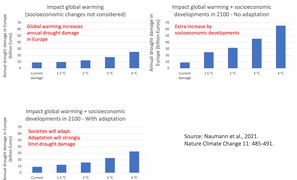Drought magnitude and frequency in Ireland will increase in the summer

Yes, the Republic of Ireland is also vulnerable to droughts. The summer of 2018 highlighted the vulnerability of Ireland to drought impacts, especially in the agriculture and water sectors. Compared to 2017, cereal yields fell 20% in 2018 and net margins of dairy farmers were 34% lower, the latter partly due to nearly 50% higher costs of animal feed. In some locations, people had to rely on water tankers to meet potable water needs. Degraded water quality adversely affected many ecosystems and species.
Changes in drought characteristics because of climate change have been estimated for the end of the century compared with the end of the previous century. Climate model projections were made for a moderate and high-end scenario of climate change. The results indicate that drought magnitude and frequency will increase in the summer, and that this increase is especially due to an increase of evaporation because of higher temperatures. Projected drought increase is largest for the high-end scenario of climate change, and for the east and midlands of the island. The duration of droughts will probably not change that much.
Similar results were found in other, recent studies. The overall picture for Ireland for the second half of this century is a tendency towards shorter, more intense droughts during the summer, typically perceived as flash droughts.
The city of Dublin in particular is vulnerable to the consequences of droughts. At present, growing water demand coupled with aging infrastructure has reduced the security of water supply for Dublin. ‘Continued growth in water demand, together with increases in drought frequency and magnitude are likely to further complicate water management in the region’, the authors conclude.
Source: Meresa and Murphy, 2023. International Journal of Climatology 43: 6523 – 6539.






